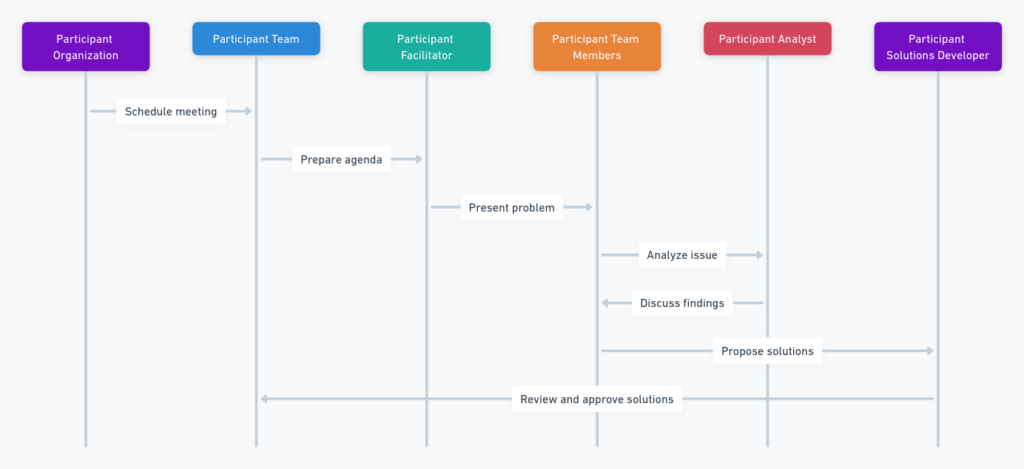Root cause analysis (RCA) meetings are critical for businesses seeking to solve problems effectively and prevent their recurrence. These sessions focus on identifying the primary source of issues within operations or systems, rather than just handling the symptoms.
A well-conducted RCA meeting can lead to significant improvements in efficiency, cost management, and employee satisfaction. Preparing for and executing these meetings properly can profoundly influence the success of your problem-solving efforts, transforming challenges into opportunities for growth.
Understanding Root Cause Analysis Meetings
Definition of Root Cause Analysis
Root cause analysis (RCA) is a systematic process used to identify the underlying causes of a problem or issue. The primary goal of RCA is to determine the fundamental origin of a defect or failure, rather than simply addressing its symptoms.
This approach ensures that measures can be taken to prevent recurrence of the issue by correcting the root causes rather than just the immediate concerns.
Importance of Root Cause Analysis Meetings

Root cause analysis meetings are crucial because they bring together the necessary stakeholders to collaboratively investigate and solve complex problems.
Such meetings enable teams to dive deep into the problem, beyond superficial fixes, ensuring a more permanent solution. They help in preventing future problems, saving time and resources that might otherwise be spent on recurring issues.
Additionally, these meetings foster a culture of transparency and continuous improvement within organizations.
Preparing for the Meeting
Setting Clear Objectives
Before convening a root cause analysis meeting, it's essential to define clear, actionable objectives. Establish what the meeting aims to achieve, such as identifying the root cause of a specific issue, developing strategies to address it, or improving organizational processes.
Clear objectives help maintain focus and ensure that the discussion remains on track.
Selecting the Right Team Members
Choosing the right participants is critical for the success of the root cause analysis meeting. Include individuals who are directly involved with the issue as well as those who possess relevant technical knowledge or decision-making authority.
It’s beneficial to have a diverse group that can offer different perspectives, contributing to a comprehensive exploration of the problem.
Gathering Relevant Data
Collecting relevant data before the meeting is essential to provide a factual basis for discussion. This might include error reports, performance data, maintenance records, or any other documentation that can shed light on the issues being discussed.
Having this information available can accelerate the problem-solving process and enhance the accuracy of the root cause analysis, leading to more effective solutions.
Conducting the Meeting
Creating a Structured Agenda
A well-structured agenda is crucial for a root cause analysis meeting. Begin by defining the specific problem you aim to solve and outline the objectives of the meeting clearly. Include time allocations for each agenda item to ensure the meeting stays on track.
Key points should include an introduction to the problem, a review of the data collected, a session for brainstorming causes, and a segment for developing action steps.
Distributing the agenda beforehand allows participants to prepare appropriately, making the meeting more efficient and focused.
Encouraging Open Communication
Fostering an environment where all attendees feel comfortable voicing their opinions and insights is vital. Begin by setting ground rules that emphasize respect and openness in dialogue.
Encourage participation from everyone, ensuring that all perspectives are heard. Utilize techniques such as round-robin sharing or small group discussions to engage quieter members.
Acknowledge all contributions positively to maintain a collaborative atmosphere throughout the meeting.
Using Problem-Solving Techniques
Implement effective problem-solving techniques such as the "5 Whys" method to drill down to the root cause of the problem. This involves asking "Why?" multiple times until the fundamental issue is identified.
Also, consider employing fishbone diagrams to visually map out the problem and its various contributing factors. These tools can help clarify the connections and guide the team towards identifying the true root cause.
Uncovering Root Causes
Analyzing Data and Information
Begin with a thorough analysis of all relevant data and information. This might include performance reports, customer feedback, error logs, or any documentation that can provide insights into the problem. Use statistical tools to identify patterns or inconsistencies that point to potential causes. Having a team member skilled in data analysis can be particularly beneficial in efficiently interpreting complex datasets and presenting findings in an understandable format.
Identifying Contributing Factors
Once the data has been analyzed, the next step is to identify all possible contributing factors. Discuss each potential cause and test its validity by checking how it aligns with the data you've analyzed.
It’s important to consider all angles, including human, technological, and process-related factors. List these factors and use tools like the priority matrix to determine which ones have the most significant impact on the issue.
This structured approach helps in narrowing down the list to the most critical root causes that require addressing.
Discussing Solutions
Brainstorming Potential Solutions
Once the root cause is identified, the next step is brainstorming potential solutions. It's crucial to foster an open environment where all team members feel comfortable proposing ideas.
Encourage creative thinking and consider solutions from multiple perspectives, ensuring a comprehensive approach. Document each suggestion and use visualization tools like mind maps or flowcharts to organize and connect ideas, making it easier for everyone to visualize possible solutions.
Evaluating Feasibility and Impact
After generating a list of potential solutions, evaluate each based on feasibility and the impact it would have on resolving the issue. Consider factors such as resource availability, time, cost, and the potential risks associated with each solution.
This step often involves a bit of analysis to forecast outcomes and determine the sustainability of solutions over time. It’s beneficial to categorize solutions into short-term and long-term to better align them with strategic objectives.
Prioritizing Actions
Prioritize the solutions based on the evaluation criteria. Tools such as a prioritization matrix can be useful here, helping to visualize which actions will provide the most significant benefit relative to their cost and feasibility.
Focus on quick wins that can be implemented easily to build momentum and gain stakeholder support for more complex solutions.
Implementing and Monitoring Solutions
Developing an Action Plan
With priorities set, develop a detailed action plan that outlines the steps needed to implement each solution. This plan should include specific milestones, deadlines, and the resources required.
It's important to be as detailed as possible to provide a clear framework for the implementation process. Each action item should be aligned with the overarching goal of addressing the root cause identified earlier in the process.
Assigning Responsibilities
Assign clear responsibilities to team members for each action step. Ensure that everyone involved understands their tasks, the expectations set, and the timeline for delivery.
Utilize strengths and expertise within the team to maximize efficiency and effectiveness. Regular team meetings can help keep everyone accountable and provide an opportunity to address any challenges they face during the implementation phase.
Establishing Follow-Up Mechanisms
Establish mechanisms for monitoring the implementation of solutions and evaluating their effectiveness. This could include regular progress reviews, updates meetings, and feedback sessions.
It's essential to measure whether the solutions are effectively addressing the root cause and achieving the desired outcomes. Adjustments should be made as necessary, based on feedback and the results observed from the monitoring processes.
This ongoing evaluation helps ensure the long-term success of the solutions implemented.
Effective Communication During and After the Meeting

Providing Clear Instructions
Establishing clear instructions at the onset of a root cause analysis meeting sets the stage for success. Begin by clearly defining the purpose of the meeting and what the team hopes to accomplish.
Outline the process that will be followed and assign roles to participants to ensure everyone knows their responsibilities. Use simple, specific language and verify understanding by asking team members to summarize their tasks.
Communicating Progress and Updates
Throughout the root cause analysis process, keep all stakeholders informed with regular updates.
Use emails, brief meetings, or project management tools to share the progress of the analysis, key findings, and any adjustments in the approach. This not only keeps everyone aligned but also builds trust and maintains engagement among team members.
Seeking Feedback for Continuous Improvement
After the meeting, actively seek feedback from participants on the analysis process, the effectiveness of the meeting, and the solutions derived. This can be done through surveys, one-on-one dialogues, or a follow-up meeting.
Encourage honest feedback and discuss openly what worked well and what could be improved. This practice not only helps in refining the current strategy but also enhances future root cause analysis efforts.
Book a Demo and experience ContextQA testing platform in action with a complimentary, no-obligation session tailored to your business needs.
Conclusion
Incorporating the aforementioned tips in your root cause analysis meetings will significantly enhance their effectiveness. By engaging participants, gathering the right data, following structured methods, and actively facilitating discussion, you foster an environment more conducive to identifying and resolving core issues.
Remember, the primary goal is to achieve a comprehensive understanding of the problem and jointly develop actionable solutions.
Applying these strategies not only streamlines the process but also contributes to sustained improvements within your organization.
Also Read - How to Measure Software Testing Success with DORA Metrics
